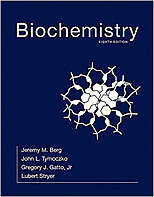
Biochemistry
Berg, Jeremy M.; Tymoczko, John L.; Gatto, Jr., Gregory J.; Stryer, Lubert
8 ed.
New York: W.H. Freeman and Company, 2015
 |
Biochemistry Berg, Jeremy M.; Tymoczko, John L.; Gatto, Jr., Gregory J.; Stryer, Lubert 8 ed. New York: W.H. Freeman and Company, 2015 |
33 termes
| b subunit n. |
|
| Bacillus amyloliquefaciens [nom científic] |
|
| Bacillus subtilis [nom científic] |
|
| bacterial gene expression n. |
|
| bacterial reaction center n. |
|
| bad cholesterol n. |
|
| barbed end n. |
|
| basal transcription apparatus n. |
|
| base composition n. |
|
| base-exchange reaction n. |
|
| base-excision repair n. |
|
| base-pair substitution n. |
|
| BCCP n. (Biotin carboxyl carrier protein) |
|
| B-cell activation n. |
|
| Bcr-Abl kinase n. |
|
| benzoyl CoA n. |
|
| B-form DNA n. |
|
| bile acid n. |
|
| bimolecular sheet n. |
|
| biological process n. |
|
| biological system n. |
|
| biotin carboxyl carrier protein n. (BCCP) |
|
| bitter receptor n. |
|
| blood level n. |
|
| Blosum-62 n. |
|
| blotting technique n. |
|
| Boltzmann's constant n. |
|
| bond cleavage n. |
|
| bound zinc n. |
|
| branched pathway n. |
|
| brown adipose tissue n. (BAT) |
|
| brown fat mitochondria n. |
|
| building block n. |
|